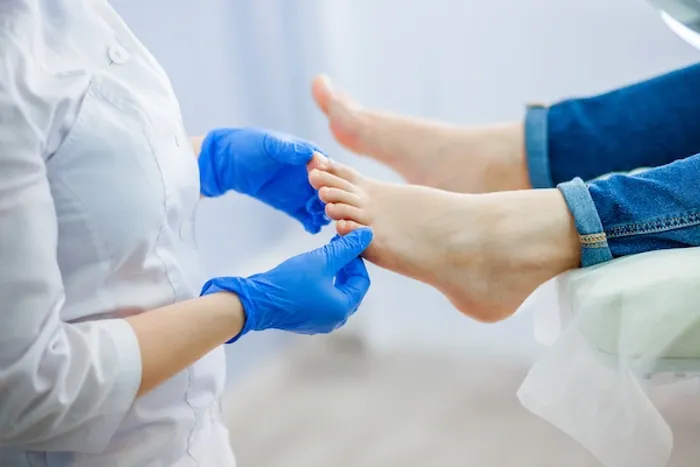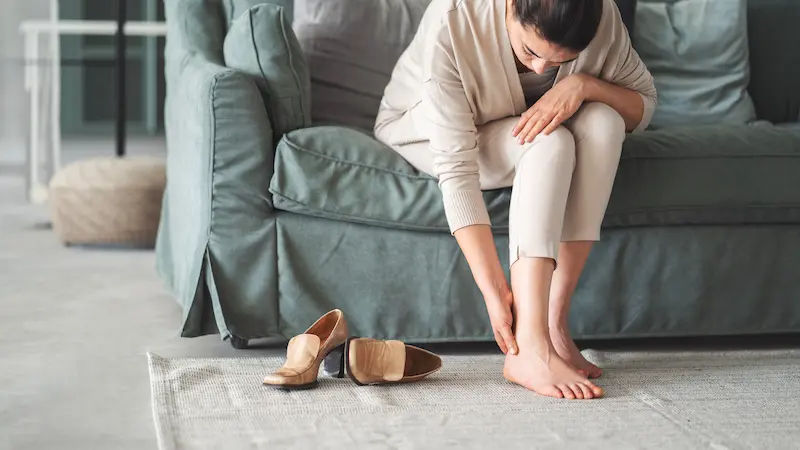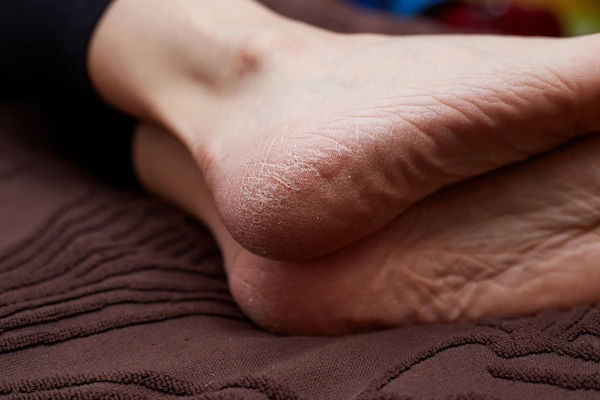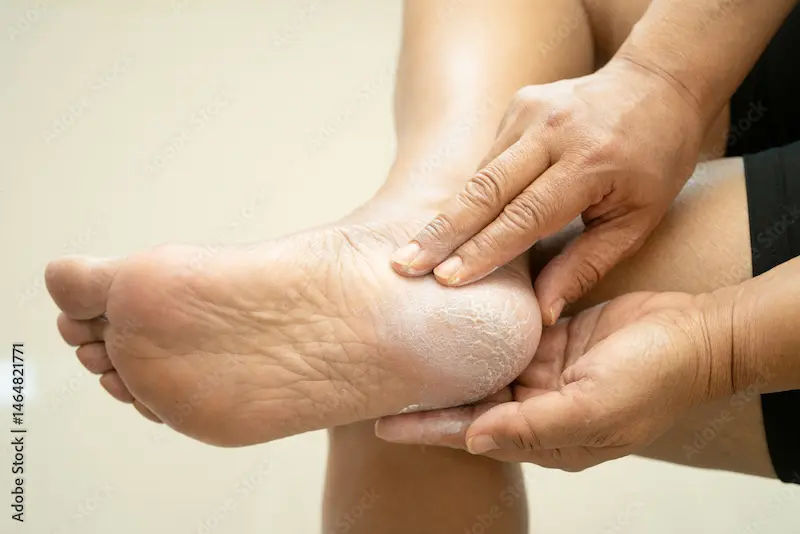Guide to Podiatry
Guide to Podiatry: Learn about foot and ankle care, common conditions (like bunions, plantar fasciitis), treatments, and when to see a podiatrist. Keep your feet healthy!

Written by Dr. M L Ezhilarasan
Reviewed by Dr. Dhankecha Mayank Dineshbhai MBBS
Last updated on 24th Oct, 2025

Introduction
Healthy feet and ankles carry you through life, yet many of us ignore them until pain strikes. Podiatry is the medical specialty focused on diagnosing, treating, and preventing conditions of the foot and ankle—from nagging heel pain and ingrown toenails to complex issues like diabetic foot ulcers and sports injuries. Whether you’re a runner battling plantar fasciitis, a parent worried about a child’s flat feet, or someone with diabetes trying to prevent complications, the right podiatry care can keep you active and reduce your risk of long-term problems.
In this comprehensive guide to podiatry, you’ll learn what podiatrists do, when to seek help, and how common foot and ankle conditions are diagnosed and treated. We’ll cover practical home care tips, shoe-buying advice, and how to find the right specialist. You’ll also discover the latest technologies—from pressure mapping to 3D-printed orthotics—along with evidence-based treatments and clear red flags for urgent care. Let’s step into better foot health together.
What Is Podiatry? Scope and Training
Podiatry is the medical specialty that focuses on the foot and ankle, including skin, nails, bones, joints, tendons, and nerves. A podiatrist is trained to diagnose and treat a wide range of issues—from common problems like plantar fasciitis and ingrown toenails to complex conditions such as diabetic foot ulcers, deformities, and fractures. Podiatrists often coordinate care with primary care clinicians, endocrinologists (for diabetes), sports physicians, and orthopedists when advanced surgery is needed.
Podiatrists typically earn a Doctor of Podiatric Medicine (DPM) degree, followed by hospital-based residency training in foot and ankle medicine and surgery. Many become board certified and may pursue subspecialties (e.g., sports podiatry, pediatric podiatry, wound care). In some countries, you may see the term “chiropody” used interchangeably with podiatry, though modern practice generally uses “podiatry” and encompasses a broader, more medical scope than traditional chiropody.
How podiatrists differ from orthopedists and physiotherapists?
Orthopedists (MD/DO) are surgeons specializing in the musculoskeletal system; many focus on hip, knee, or spine, while foot/ankle orthopedists manage complex trauma, deformities, and reconstructive surgeries. Podiatrists are the primary medical specialists devoted exclusively to the foot and ankle, often the first stop for non-surgical and surgical care.
Physiotherapists/physical therapists provide rehabilitation, strengthening, and manual therapy. Podiatrists frequently collaborate with PTs; a podiatrist might diagnose, prescribe orthotics, and perform procedures, while PTs carry out rehab plans.
Training, credentials, and subspecialties
- Education: DPM (US) or equivalent qualifications internationally.
- Residency: Typically 2–3 years covering medicine, surgery, and wound care.
- Board certification: Signals advanced expertise.
- Subspecialties: Sports podiatry, diabetic limb preservation, pediatric podiatry, minimal incision surgery, and more.
Unique insight: Think of podiatry as the “primary care” and “specialty care” for your feet combined—uniquely positioned to prevent, diagnose, and treat across the spectrum, and to know when to escalate to other specialists.
Consult a Top General Physician
When to See a Podiatrist?: Signs and Symptoms
If your feet or ankles hurt, don’t wait for the problem to become chronic. See a podiatrist if you experience:
- Persistent heel pain, especially first steps in the morning (common in plantar fasciitis).
- A painful bunion, hammertoe, or swelling that interferes with footwear.
- Ingrown toenails (redness, swelling, drainage) or recurring fungal nail infections.
- New numbness, tingling, or burning (possible nerve entrapment or diabetic neuropathy).
- Recurrent ankle sprains, instability, or Achilles tendon pain with activity.
- Wounds, blisters, or calluses that don’t heal—especially if you have diabetes.
Red flags that need urgent attention
- Signs of infection: spreading redness, warmth, severe pain, fever, foul odor.
- Sudden severe swelling, deformity, or inability to bear weight (possible fracture).
- A foot ulcer or wound that’s deep, draining, or not improving within a week.
- Rapidly worsening pain after an injury.
If symptoms persist beyond two weeks, consult a doctor online with Apollo 24|7 for further evaluation, or book a physical visit with a podiatry or foot and ankle specialist. Telepodiatry is useful for triage, follow-up, and reviewing imaging.
What to bring to your appointment?
- Your most-worn shoes and athletic footwear (the wear pattern is diagnostic).
- A list of symptoms, when they occur, and what worsens/relieves them.
- Previous imaging, orthotics, or inserts you’ve tried.
- A medication list and relevant health history (diabetes, arthritis, psoriasis).
Unique insight: Photograph your feet at the end of a typical day for a week—swelling patterns, redness, or asymmetry can help your podiatrist see what you see at home.
Common Foot and Ankle Conditions Explained
Plantar fasciitis and heel pain
Plantar fasciitis is a leading cause of heel pain, marked by sharp pain with first steps after rest. Risk factors include sudden increases in activity, tight calves, poor footwear, and prolonged standing. Evidence supports a combination of calf and plantar fascia stretching, activity modification, and supportive shoes/orthotics; many cases improve within weeks to months with conservative care. Shockwave therapy and night splints are options for persistent cases.Related terms: heel pain causes and treatment; plantar fasciitis treatment at home.
Bunions and hammertoes
A bunion (hallux valgus) is a bony prominence at the base of the big toe, often with a deviated toe. Tight, narrow shoes and genetics play a role. Conservative care includes wider toe boxes, padding, spacers, and orthotics to redistribute pressure. When pain and deformity limit function despite conservative measures, bunion surgery may be considered; recovery timelines vary by procedure and activity level. Hammertoes (toe contractures) often coexist and may require similar strategies.
Ingrown toenails and nail disorders
Ingrown toenails occur when the nail edge grows into the skin, causing pain and infection. Risk factors include curved nails, tight shoes, and improper trimming. Podiatry care may include partial nail avulsion with phenolization (to prevent recurrence), antibiotics for infection, and footwear advice. Fungal nails (onychomycosis) are common—treatments range from topical agents to oral medications; your clinician may confirm diagnosis before systemic treatment.
Achilles tendinopathy and ankle sprains
Achilles tendinopathy presents as tendon pain and stiffness, often in runners or after a training change. Evidence supports eccentric calf strengthening, load management, and addressing footwear. Ankle sprains are frequent; early diagnosis and rehabilitation reduce recurrence. Balance training and appropriate bracing during return to sport are key. For stubborn soft-tissue injuries, podiatrists may consider ultrasound-guided injections or shockwave therapy. [1]
- Unique insight: A “shoe rotation” (alternating between two supportive pairs) can reduce repetitive stress on the same tissue lines—helpful for plantar fasciitis and Achilles issues.
Diagnosis in Podiatry: From Exam to Gait Analysis
Physical exam, imaging, and lab tests
A podiatry visit begins with a detailed history and physical: assessing alignment, range of motion, tenderness, callus patterns, nail health, pulses, and nerve function. Imaging may include:
- X-rays for bone alignment, bunions, hammertoes, and suspected fractures.
- Ultrasound for plantar fascia thickness or tendon evaluation.
- MRI for complex soft-tissue injuries, stress fractures, or unresolved pain.
Lab tests are considered when systemic contributors are suspected—e.g., HbA1c for diabetes control, uric acid if gout is on the differential, or vitamin D when bone stress or recurrent tendon issues raise suspicion. Apollo 24|7 offers a convenient home collection for tests like vitamin D or HbA1c if your clinician recommends them.
Gait analysis and pressure mapping
Abnormal gait and pressure distribution can drive pain and calluses. Many podiatry clinics offer:
- Video gait analysis to assess stride mechanics.
- Pedobarography (pressure mapping) to identify high-pressure zones that may benefit from orthotic offloading.
- Functional assessments (single-leg balance, calf endurance) to personalize rehabilitation.
Unique insight: Bring the insoles from your shoes. The imprint can reveal hotspots and pronation/supination patterns, providing clues even before formal pressure mapping.
Treatments and Procedures: From Orthotics to Surgery
Conservative care (RICE, meds, physical therapy)
Most foot and ankle issues respond to conservative care:
- RICE (Rest, Ice, Compression, Elevation) after acute injuries.
- NSAIDs or topical analgesics for short-term pain relief.
- Targeted physical therapy: eccentric calf loading for Achilles tendinopathy; plantar fascia
- specific stretching for heel pain; balance and proprioception work after ankle sprain. [5]
- Taping and bracing to support healing tissues.
Orthotics and footwear modifications
Custom orthotics for flat feet or high arches can redistribute pressure, correct alignment, and reduce strain on the plantar fascia and Achilles. Off-the-shelf insoles also help when matched to your arch and shoe type. Footwear modifications—wider toe boxes for bunions, rockered soles for forefoot pain, and stable heel counters for overpronation—are often first-line. Related terms: custom orthotics for flat feet; best shoes for plantar fasciitis.
Office procedures and surgical options
When conservative measures are insufficient:
- In-office procedures: partial nail avulsion for ingrown toenails; callus debridement; corticosteroid or platelet-rich plasma injections under ultrasound guidance in select cases.
- Shockwave therapy for chronic plantar fasciitis and tendinopathies.
- Minimally invasive or open surgery for bunions, hammertoes, Achilles tears, neuromas, or advanced arthritis. Recovery depends on the procedure, fixation used, and adherence to rehab protocols.
Unique insight: If you’re prescribed orthotics, request a “break-in” schedule and a follow-up adjustment. Small tweaks in posting or padding can transform comfort and outcomes.
Special Considerations: Athletes, Kids, Seniors, and Diabetes
Sports podiatry for runners and team sports
Athletes benefit from early diagnosis, load management, and sport-specific shoe guidance. Runners with heel pain might need a temporary reduction in mileage, cadence adjustments, and a graded return-to-run plan, while court athletes may require lateral stability shoes and ankle bracing. Periodized strengthening (hip/knee/foot) reduces re-injury.
Pediatric podiatry: when flat feet matter
Flexible flat feet are common in children and often asymptomatic. Seek podiatry input if pain, frequent tripping, or severe asymmetry occurs. Interventions may include activity-specific footwear, strengthening of intrinsic foot muscles, and orthotics in select cases. Early guidance supports healthy activity and reduces discomfort.
Geriatric foot care and fall prevention
With age, skin thins and balance declines. Regular podiatry care addresses calluses, nail problems, and footwear fit to prevent falls. For neuropathy or poor circulation, routine checks can catch ulcers early. Simple balance drills and appropriate shoes (low heel, wide toe box, non-slip sole) improve safety.
Diabetes and foot health: prevention and monitoring
People with diabetes face higher risks of neuropathy, infections, and non-healing ulcers. Daily foot checks, moisture control, and protective footwear are critical. Evidence-based care emphasizes blood sugar control, regular podiatry exams, and prompt treatment of any blister or sore to prevent progression. If you notice a wound that isn’t improving within a few days, consult a doctor online with Apollo 24|7 or book a physical visit for urgent evaluation. Apollo 24|7 can also arrange home collection for HbA1c testing to monitor diabetes control.
Unique insight: Put a small inspection mirror near your shoes. Making daily checks effortless increases the chance you’ll spot early problems—especially vital in diabetes.
Preventive Foot Care and Footwear Tips
Daily foot care routine and hygiene
- Wash and dry thoroughly, especially between toes; moisturize heels and soles (not between toes).
- Trim nails straight across; don’t dig into corners (reduces ingrown nails).
- Use breathable socks; change damp socks promptly to prevent fungal issues.
- For salon pedicures, avoid aggressive cuticle trimming and ensure sterilization standards.
Shoe fit checklist and insoles
- Length: Thumbnail-width space beyond your longest toe.
- Width: No pinching across the forefoot; your toes should splay freely.
- Depth: Nails shouldn’t hit the upper; sufficient volume for orthotics if used.
- Stability: Firm heel counter; torsional resistance; midfoot support.
- Activity match: Running shoes for running, court shoes for lateral sports, hiking boots for trails.
Related terms: podiatry vs orthopedics (choosing the right specialist for shoe advice); foot and ankle specialist near me.
Stretching and strength for resilient feet
- Morning plantar fascia stretch: Cross your legs, pull your toes back 10–20 seconds, repeat 3–5 times.
Calf stretches (knee straight and bent) 30–45 seconds, 2–3 sets.
- Intrinsics: Towel scrunches, short foot exercise, and heel raises (progress to single-leg).
- Balance: Single-leg stance with eyes open, then closed; add head turns to challenge stability.
- Unique insight: Treat your shoes like tires—rotate pairs and log miles. Most running shoes last ~500–800 km; supportive work shoes may need replacement annually depending on use.
Choosing a Podiatrist, Costs, and Your First Visit
How to evaluate qualifications and reviews?
- Credentials: DPM (or country-equivalent), board certification, and hospital affiliations.
- Experience: Conditions you need help with—sports injuries, bunions, pediatric care, or diabetic wound management.
- Communication: Clear explanations and shared decision-making style.
- Clinic capabilities: Access to imaging, gait analysis, and orthotic services.
Costs, insurance, and telepodiatry
Costs vary by region and complexity; initial assessments typically cost more than follow-ups. Insurance coverage differs—many plans cover medically necessary visits and procedures, orthotics may have variable coverage. Telepodiatry (online consultation) is useful for triage, education, and reviewing test results, though hands-on exam is often required for definitive diagnosis. Related term: podiatry costs and insurance.
What happens during your first visit?
Expect a detailed history, foot and ankle exam, footwear assessment, and discussion of your goals. You may receive a home program (stretches, footwear changes), imaging orders, and a follow-up plan. If your condition does not improve after trying these methods, book a physical visit to a doctor with Apollo 24|7 or arrange a referral to a foot and ankle specialist.
- Unique insight: Ask for a written “return-to-activity” roadmap with milestones. Clear checkpoints (e.g., pain-free single-leg hops) help you progress safely and confidently.
Conclusion
Your feet and ankles are the foundation of an active, healthy life—and podiatry is the specialty designed to keep that foundation strong. From diagnosing heel pain and treating ingrown toenails to preventing diabetic ulcers and optimizing athletic performance, podiatrists blend medical, biomechanical, and sometimes surgical expertise to solve problems and prevent new ones. Most conditions respond well to a smart plan: the right shoes, targeted exercises, and, when appropriate, orthotics or office procedures. Advanced tools like gait analysis and pressure mapping allow care to be customized to your unique movement patterns.
If you’re noticing pain, swelling, numbness, or a wound that doesn’t heal, don’t wait. Early assessment can shorten recovery and protect you from complications—especially if you have diabetes or circulation problems. If symptoms persist beyond two weeks, consult a doctor online with Apollo 24|7 for further evaluation, or book an in-person visit to get hands-on care and a clear plan forward. Take the next step today—your future self will thank you with every comfortable stride.
Consult a Top General Physician
Consult a Top General Physician

Dr Vinay Kumar A V
Nephrologist
8 Years • MBBS, MD - General Medicine, DM - Nephrology
Bilaspur
Apollo Hospitals Seepat Road, Bilaspur

Dr. Aakash Garg
Gastroenterology/gi Medicine Specialist
12 Years • MBBS, DNB (Medicine), DrNB (Gastroentrology).
Bilaspur
Apollo Hospitals Seepat Road, Bilaspur
(150+ Patients)

Dr. Sandhya Chandel
General Physician/ Internal Medicine Specialist
16 Years • MBBS, MD (Int. Med.), IDCCM
Bilaspur
Apollo Hospitals Seepat Road, Bilaspur
(125+ Patients)

Dr. Hariprasath J
General Physician/ Internal Medicine Specialist
19 Years • MD (Gen Med), FCCP, Dip (Diabetology, UK)
Chennai
Apollo First Med Hospitals P H Road, Chennai
(200+ Patients)

Dr. Abhishek Ranjan
General Practitioner
4 Years • MBBS
Kolkata
VDC Clinic, Kolkata
Consult a Top General Physician

Dr Vinay Kumar A V
Nephrologist
8 Years • MBBS, MD - General Medicine, DM - Nephrology
Bilaspur
Apollo Hospitals Seepat Road, Bilaspur

Dr. Aakash Garg
Gastroenterology/gi Medicine Specialist
12 Years • MBBS, DNB (Medicine), DrNB (Gastroentrology).
Bilaspur
Apollo Hospitals Seepat Road, Bilaspur
(150+ Patients)

Dr. Sandhya Chandel
General Physician/ Internal Medicine Specialist
16 Years • MBBS, MD (Int. Med.), IDCCM
Bilaspur
Apollo Hospitals Seepat Road, Bilaspur
(125+ Patients)

Dr. Hariprasath J
General Physician/ Internal Medicine Specialist
19 Years • MD (Gen Med), FCCP, Dip (Diabetology, UK)
Chennai
Apollo First Med Hospitals P H Road, Chennai
(200+ Patients)

Dr. Abhishek Ranjan
General Practitioner
4 Years • MBBS
Kolkata
VDC Clinic, Kolkata
More articles from Foot Cracks
Frequently Asked Questions
What does a podiatrist do?
A podiatrist diagnoses and treats foot and ankle problems, including heel pain, bunions, ingrown toenails, sprains, and diabetic foot issues, using conservative care, orthotics, office procedures, and surgery when needed. Related term: what does a podiatrist do.
How do I know if I need custom orthotics?
If you have recurring foot pain, overuse injuries, or pressure-related calluses that don’t improve with supportive shoes and exercises, a podiatrist may recommend custom orthotics for flat feet or high arches to redistribute pressure and improve alignment.
Are telepodiatry visits effective?
Telepodiatry is effective for triage, education, reviewing imaging, and follow-up. Hands-on exams are often needed for final diagnosis. If symptoms persist beyond two weeks, consult a doctor online with Apollo 24|7 to decide next steps.
What are the best shoes for plantar fasciitis?
Shoes with a supportive arch, cushioned heel, slight rocker sole, and firm heel counter often help. A podiatrist can also recommend insoles or custom orthotics and a plantar fasciitis treatment at home plan tailored to you.
I have diabetes. How often should I see a podiatrist?
At least annually for a foot exam—more often if you have neuropathy, deformities, or previous ulcers. Daily self-checks are essential. Apollo 24|7 offers home collection for HbA1c to help monitor diabetes control between visits.


